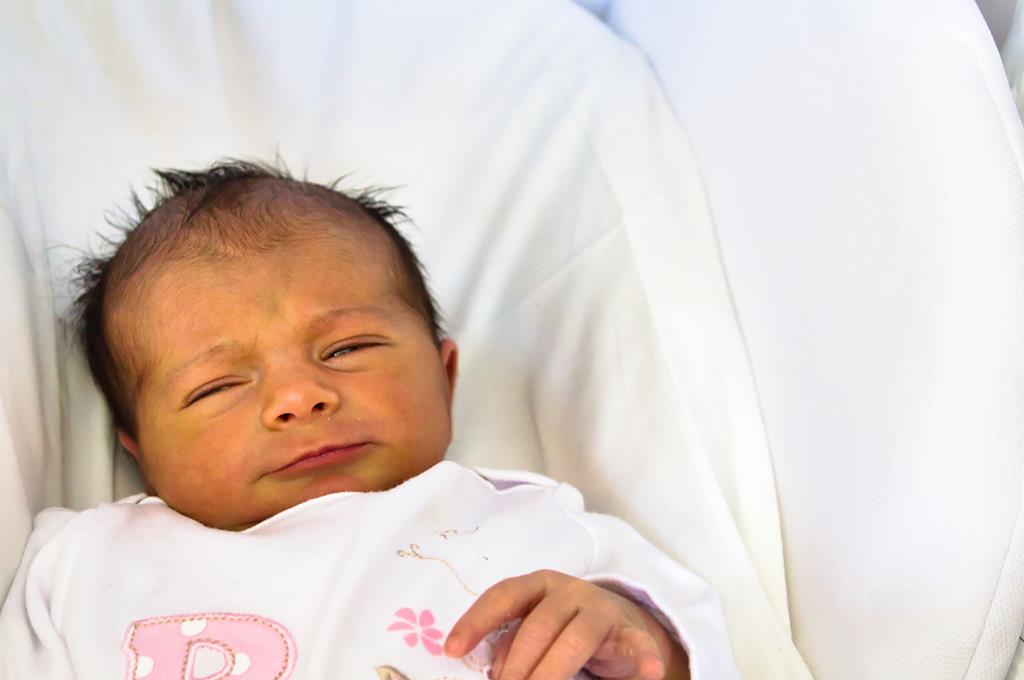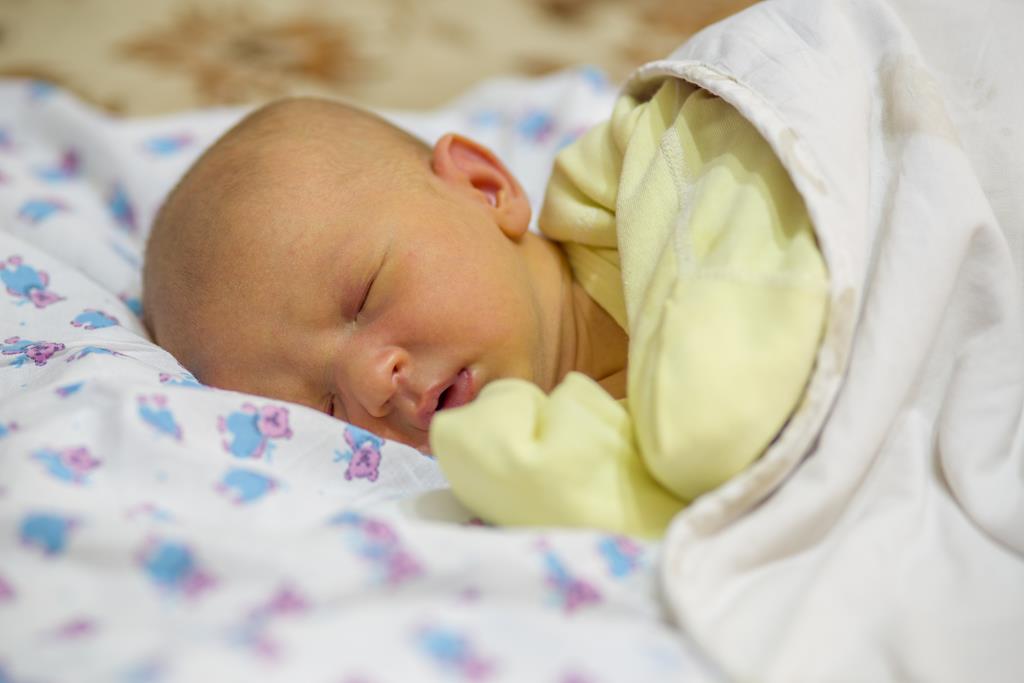Newborn Jaundice 101

A newborn with yellowish skin and eyes may have jaundice. Jaundice will appear first on the face and then spread to the chest, stomach, and legs. Jaundice can be harder to detect in infants with darker skin tones. If you are concerned that your baby may have jaundice, gently press the skin of your baby’s nose or forehead in; if your child has jaundice, the skin will appear yellow when you lift your finger. If your child does not have jaundice, the skin color will just look slightly lighter than its normal color for a moment. The yellowing of a baby’s skin and eyes is most often caused by an excess of bilirubin in the baby’s blood, but can occasionally be caused by an underlying condition.
Symptoms of Jaundice
The clearest indicator of jaundice is its trademark yellowing of the skin and whites of the eyes. This discoloration typically appears between the second and fourth day after birth. Your baby should be checked for jaundice between the third and seventh day after birth, as this is when bilirubin levels generally peak. The American Academy of Pediatrics recommends that newborns be examined for jaundice at least every eight to 12 hours while in the hospital. Most hospitals perform routine checks of all babies for jaundice before discharge. If your baby is discharged earlier than 72 hours after your delivery, call Entirely Kids Pediatrics for an appointment to check for jaundice within two days of discharge.
The following symptoms may indicate jaundice or complications from excess bilirubin.
- The skin on your baby’s chest, abdomen, arms, or legs looks yellow
- The whites of your infant’s eyes look yellow
- Your baby seems overly tired, listless, or sick
- Your baby is difficult to awaken from sleep
- Your baby is failing to thrive, not gaining weight appropriately, or is feeding poorly
- High-pitched crying
Causes of Jaundice
Bilirubin is a yellow pigment of red blood cells resulting from the normal breakdown of these cells. In a healthy infant, the liver removes bilirubin from the blood, directs the bilirubin into the child’s bowels, and it is then passed from the body. In the first few days of life, a newborn will produce more bilirubin than an adult due to greater production and faster breakdown of red blood cells. However, in a newborn with jaundice, the infant’s liver may not be mature enough to remove bilirubin as efficiently as it should. Jaundice results when bilirubin accumulates before the liver can remove it from the bloodstream and pass it from the baby’s body.
Excess bilirubin (hyperbilirubinemia) is the main cause of jaundice. Jaundice due to these normal newborn conditions is called physiologic jaundice. It often occurs between the second and fourth days of life. However, an underlying condition can occasionally cause infant jaundice. Diseases or conditions that can cause jaundice include:
- An infection in your baby’s blood (sepsis)
- A liver malfunction
- An enzyme deficiency
- An abnormality of your baby’s red blood cells that causes them to break down rapidly
- Biliary atresia, a condition in which the baby’s bile ducts are blocked or scarred
- Internal bleeding (hemorrhage)
- Incompatibility between the mother’s blood and the baby’s blood
- Other viral or bacterial infections
Risk factors for Jaundice
Premature birth
A preterm baby born before 38 weeks of gestation may not be able to process bilirubin as efficiently as a full-term baby can. A premature baby also may feed less and have fewer bowel movements, resulting in less bilirubin being passed from the body.
Significant bruising during birth
Newborns bruised during delivery may have higher levels of bilirubin from the breakdown of more red blood cells.
Blood type Incompatibility
If the mother and baby’s blood types differ, the mother’s body makes antibodies that attack the baby’s red blood cells. This can occur when the mother’s blood type is O and the baby’s blood type is A or B (ABO incompatibility). It can also occur when the mother’s Rh factor (a protein found on red blood cells) is negative and the baby is Rh positive. The baby receives antibodies through the placenta that cause abnormally rapid breakdown of red blood cells.
Breast-feeding
Although breast-feeding your baby is generally a healthier option, breast-fed babies are at higher risk of jaundice. A mother’s milk may not be coming in quickly enough or the baby may have trouble nursing. Babies who don’t feed well can experience dehydration or a low caloric intake that contribute to the development of jaundice. However, because of the benefits of breast-feeding, experts still recommend it. A breastfeeding (lactation) consultant can help.
Race
Studies show that babies of East Asian ancestry have an increased risk of developing jaundice.
Complications of Jaundice
Bilirubin is toxic to cells of the brain. If your baby has jaundice, it’s very important to get him or her checked out by Dr. Leung. High levels of bilirubin that cause severe jaundice can result in serious complications if not treated. These complications can include:
Acute bilirubin encephalopathy
If a baby has severe jaundice, there’s a risk of bilirubin passing into the brain, a condition called acute bilirubin encephalopathy. Prompt treatment may prevent significant lasting damage, so please call our office right away for an appointment at 469-425-3600.
Signs of acute bilirubin encephalopathy include:
- Backward arching of the neck and body
- Difficulty waking
- Fever
- High-pitched crying
- Listlessness
- Poor sucking or feeding
Kernicterus
Kernicterus is the syndrome that occurs if acute bilirubin encephalopathy does permanent damage to the brain. Kernicterus may result in:
- Hearing loss
- Improper development of tooth enamel
- Involuntary and uncontrolled movements (athetoid cerebral palsy)
- Permanent upward gaze
Jaundice Diagnosis
While jaundice is often diagnosed on the basis of appearance, it is still necessary to measure the level of bilirubin in your child’s blood. The amount of bilirubin detected indicates the severity of the jaundice and aids in determining the best course of treatment. These tests usually include not only a physical exam, but a lab test of your baby’s blood or a skin test with a device called a transcutaneous bilirubinometer. If there is any indication your newborn’s jaundice could be caused by an underlying condition, additional blood tests or urine tests may be required.

Jaundice Treatment
A mild case of infant jaundice usually resolves on its own within two to three weeks. However, moderate or severe cases of jaundice may require extended time in the hospital after birth or re-admittance. Treatments used to lower the level of bilirubin in your child’s blood may include:
Enhanced nutrition
To prevent weight loss, Dr. Leung may recommend that you feed more frequently or supplement to ensure that your baby’s nutritional needs are met.
Light therapy (phototherapy)
Your baby may be placed under a special lamp that emits light in the blue-green spectrum. Light therapy may also be supplemented with the use of a light-emitting pad or mattress. This light modifies the shape and structure of bilirubin molecules so that they can be passed from the body in urine and stool. During a treatment, your child would wear only a diaper and protective eye patches.
Intravenous immunoglobulin (IVIg) and exchange transfusion
When jaundice is related to blood type differences between mother and baby, intravenous transfusion of an immunoglobulin, which is a blood protein that can reduce levels of antibodies, could decrease jaundice and decrease the need for an exchange transfusion. When severe jaundice is not responding to other treatments, an exchange transfusion of blood may be required. This involves repeatedly withdrawing small amounts of blood and replacing it with donor blood, diluting the bilirubin and maternal antibodies. This procedure is performed in a newborn intensive care unit.
Jaundice Prevention
The most effective way to prevent newborn jaundice is sufficient feeding.
Feeding guidelines:
- Breast-fed infants should have eight to 12 feedings per day for the first week of life.
- Formula-fed infants should have 1 to 2 ounces (about 30 to 60 milliliters) of formula every two to three hours for the first week.
